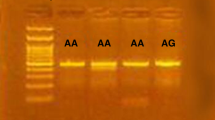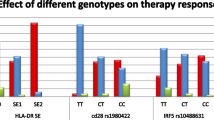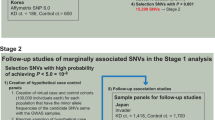Abstract
Juvenile idiopathic arthritis (JIA) is one of the most common forms of pediatric chronic arthritis. JIA is a clinically heterogeneous disease. Therefore, the genetic background of JIA may also be heterogeneous. The aim of this study was to investigate associations between human leukocyte antigen (HLA) and susceptibility to JIA and/or uveitis, which is one of the most devastating complications of JIA. A total of 106 Japanese articular JIA patients (67 with polyarthritis and 39 with oligoarthritis) and 678 healthy controls were genotyped for HLA-A, -B and -DRB1 by PCR-sequence-specific oligonucleotide probe methodology. HLA-A*02:06 was the risk factor for JIA accompanied by uveitis after adjustment for clinical factors (corrected P-value <0.001, odds ratio (OR) 11.7, 95% confidence interval (CI) 3.2–43.0). On the other hand, HLA-DRB1*04:05 was associated with polyarticular JIA (corrected P-value <0.001, OR 2.9, 95% CI 1.7–4.8). We found an association of HLA-A*02:06 with susceptibility to JIA accompanied by uveitis, which might be considered a separate clinical JIA entity. We also found an association between HLA-DRB1*04:05 and polyarticular JIA. Thus, clinical subtypes of JIA can be classified by the presence of the specific HLA alleles, HLA-A*02:06 and DRB1*04:05.
Similar content being viewed by others
Introduction
Juvenile idiopathic arthritis (JIA) is one of the most common forms of pediatric chronic arthritis, with an incidence of approximately about 10 per 100 000 children less than 16 years old.1 JIA is clinically classified into subtypes, such as systemic arthritis, oligoarthritis and polyarthritis, according to the International League of Associations for Rheumatology (ILAR) classification criteria for JIA.2
JIA is the leading cause of chronic anterior uveitis in pediatric cases, accounting for 30–40% of incidence.3, 4 The prevalence of JIA-associated uveitis varies among different ethnic groups. Children of European ancestry have a higher relative risk for developing JIA-associated uveitis than those of non-European ancestry.5 Risk factors for developing JIA-associated uveitis include antinuclear antibody positivity, early age at onset of JIA and female gender.3, 5 However, the contribution of each risk factor may also vary among ethnic groups, presumably because of variations in genetic background.6
Human leukocyte antigen (HLA) typing is considered useful for assisting in the diagnosis of autoimmune disease-associated uveitis such as HLA-B27-associated uveitis.7 It has also been reported that HLA-DRB1*13 is associated with susceptibility to JIA-associated uveitis in a Caucasoid population.8 Because the distribution of HLA alleles vary in different ethnic groups, the HLA-linked genetic background for JIA is also likely to vary among different populations. Currently, there is no information in the literature on the association between JIA-associated uveitis and HLA in Japanese. The aim of this study was therefore to investigate the association between HLA genes and clinical subtypes of JIA, especially JIA accompanied by uveitis in Japanese children.
This is the first report on the association between HLA alleles and JIA accompanied by uveitis in the Asian population.
Materials and methods
Studied population
Patients were eligible, if they met the ILAR classification criteria for JIA oligoarthritis or polyarthritis (articular JIA).2 All patients enrolled in this study were followed-up at the Yokohama City University Hospital between December 2006 and November 2009. A total of 106 Japanese articular JIA patients (86 female and 20 male; 67 with polyarthritis and 39 with oligoarthritis) were included in this study. Clinical data, including age at onset of arthritis and uveitis, gender, antinuclear antibody, rheumatoid factor and anti-cyclic citrullinated peptide status, were reviewed. Presence of uveitis was diagnosed by ophthalmologists at routine visits every 6 months. Written informed consent was obtained from each patient and/or their guardians. Japanese healthy control subjects (n=678) were randomly selected, and an informed consent was obtained from each subject before blood sampling.
The study was performed in accordance with the Declaration of Helsinki, and the study protocol was approved by the Yokohama City University School of Medicine Ethics Committee and the Ethics Committee of Medical Research Institute, Tokyo Medical and Dental University.
HLA genotyping
JIA patients were genotyped for HLA-A, -B and -DRB1 by the PCR-sequence-specific oligonucleotide probe (SSOP)–Luminex method using Genosearch HLA-A, -B and -DRB1 Ver. 2 (Medical & Biological Laboratories, Nagoya, Japan), as described previously.9 HLA genotyping data from 678 healthy Japanese controls selected at random were obtained for HLA-A and -DRB1 by the PCR-SSOP-based typing method as described previously10, 11 and for HLA-B using PCR-reverse SSOP-based RELI SSOP HLA-B typing kits (Invitrogen, Carlsbad, CA, USA).
Statistical analysis
Frequencies of HLA allele carriers were calculated for each locus in patients and controls. The statistical significance of the differences in the frequencies between patients and controls was evaluated by Fisher's exact test. A corrected P-value (Pc) was calculated by multiplying the P-value by the number of alleles tested at each locus. A two-locus analysis was carried out to investigate interactions of the disease-associated HLA alleles for increasing disease susceptibility, according to the method of Svejgaard and Ryder.12
Associations between JIA-associated uveitis and clinical variables were analyzed by Student's t-test and Fisher's exact test. Multiple logistic regression analysis was performed to investigate associations with JIA-associated uveitis. All statistical analyses were carried out using SAS system version 9 (SAS Institute, Cary, NC, USA).
Results
Association between HLA and JIA susceptibility
A total of 106 articular JIA patients and 678 healthy controls were genotyped for HLA-A, -B and -DRB1 to investigate associations of HLA with JIA susceptibility. It was found that frequencies of HLA-DRB1*04:05 and HLA-A*02:06 tended to increase in the patients (P<0.05, Pc=not significant) (Table 1). Because the marginal association between HLA and JIA overall might reflect a stronger association between HLA and a specific clinical subtype of JIA, patients were stratified into polyarticular and oligoarticular types. This approach revealed that HLA-DRB1*04:05 was indeed highly significantly associated with polyarticular JIA (Pc<0.001, odds ratio (OR) 2.9, 95% confidence interval (CI) 1.7–4.8), but tended to decrease in oligoarticular JIA (Table 1). In the latter, HLA-A*02:06 and HLA-DRB1*09:01 showed a tendency toward increased frequencies, but this did not reach significance after correction for the number of alleles tested (P<0.05, Pc=not significant) (Table 1). No other HLA-A, -B or -DRB1 alleles showed any significant associations with either form of articular JIA.
Clinical and genetic characteristics of JIA accompanied by uveitis
Because different HLA alleles showed associations with different subtypes of articular JIA, it is likely that the association of HLA with JIA would reflect the association with other specific clinical manifestations. Therefore, we investigated the clinical and genetic characteristics of JIA accompanied by uveitis.
Of 106 patients with articular JIA, 13 (12.2%) developed uveitis. All the patients with uveitis were female, but the gender difference was not statistically significant (P=0.055). Mean age at onset of JIA in the patients with uveitis was 3.2 years (range 0–14) (Table 2). The mean age for developing uveitis was 5.2 years (range 1–14), and the mean time interval between the onset of JIA and development of uveitis was 21.9 months (range −4 to 48), with one case developing uveitis 4 months before the onset of JIA. Oligoarticular onset, rheumatoid factor negativity (<14 IU ml−1) and low anti-cyclic citrullinated peptide (<4.5 U ml−1), as well as younger age at onset of JIA were all significantly associated with JIA accompanied by uveitis (Table 2). Nine patients with JIA accompanied by uveitis responded well to topical corticosteroids and could discontinue medications for uveitis, but the remaining four additionally required systemic glucocorticoids or anti-tumor necrosis factor-α therapy for uveitis in the follow-up period.13
To further investigate the association between HLA and JIA accompanied by uveitis, we compared the frequencies of HLA alleles among JIA patients with or without uveitis. As shown in Table 3, the frequency of HLA-A*02:06 carriers was significantly higher in the JIA patients with uveitis (Pc<0.001, OR 11.7, 95% CI 3.2–43.0). The frequency of HLA-DRB1*09:01 carriers was also higher in patients with uveitis, although this was not statistically significant after correction for multiple testing (P=0.020, Pc=not significant) (Table 3). No other HLA-A, -B or -DRB1 alleles, including HLA-B*27 (B27), DRB1*11 (DR11) and DRB1*13 (DR13), showed any significant associations with JIA accompanied by uveitis.3, 5, 8
To investigate the contribution of HLA-A*02:06 and HLA-DRB1*09:01 with susceptibility to JIA accompanied by uveitis, we performed a two-locus analysis according to Svejgaard and Ryder (Table 4).12 This suggested a synergistic interaction of these two HLA alleles in susceptibility to this form of JIA. Thus, the odds risks conferred by A*02:06 in the presence or absence of DRB1*09:01 were 20.1 (test (3)) and 6.9 (test (4)), respectively; for DRB1*09:01 in the presence or absence of A*02:06, these values were 11.9 (test (5)) and 4.1 (test (6)), respectively (Table 4). In addition, the odds risk conferred by the presence of both HLA alleles was 81.8 (test (8)), which was much higher than A*02:06 alone (test (4)) or DRB1*09:01 alone (test (6)), further supporting a synergistic interaction.
Finally, we performed multiple logistic regression analysis to evaluate risk factors for JIA accompanied by uveitis, and demonstrated that HLA-A*02:06 was the most significant of these (P=0.014, OR 7.8, 95% CI 1.5–40.5).
Discussion
It is well known that genetic factors influence susceptibility to autoimmune disorders, such as rheumatoid arthritis and JIA.14, 15, 16 HLA is one of the most important genetic factors for these kinds of diseases; there are also ethnic differences in the contribution of HLA to disease susceptibility. In the present study, we evaluated associations between HLA and susceptibility to articular JIA and its clinical subtypes, polyarticular and oligoarticular JIA in Japanese children (Table 1). We found that HLA-DRB1*04:05 was significantly associated with polyarticular JIA, whereas HLA-A*02:06 and HLA-DRB1*09:01 tended to be associated with oligoarticular JIA. These findings imply the existence of genetic differences between the polyarticular and oligoarticular JIA.
HLA-DRB1*04:05 encodes an amino-acid sequence in the DRβ chain, which is well known as an epitope shared between the HLA-DR molecules associated with susceptibility to rheumatoid arthritis in many ethnic groups17, 18 including Japanese,19 as well as polyarticular JIA in Taiwanese.20 Although there is debate about whether rheumatoid arthritis and polyarticular JIA could be similar clinical conditions,21 HLA-DRB1*04:05 may contribute to the pathogenesis of chronic arthritis at different ages and in different ethnic groups. Further studies are required to determine the molecular mechanisms by which HLA-DRB1*04:05 contributes to pathogenesis.
Herein, we found an association of both HLA-A*02:06 and DRB1*09:01 with susceptibility to JIA accompanied by uveitis (Tables 3 and 4). In the clinical setting, the frequency of occurrence of uveitis is one of the main differences between polyarticular and oligoarticular JIA (Table 2).4 Uveitis is one of the most devastating complications of JIA, because it causes posterior synechia, band keratopathy and cataract, which can result in a poor visual prognosis.22, 23 Clinical risk factors for JIA-associated uveitis were also found to be associated with JIA-associated uveitis in Japanese (Table 2). In addition to these known risk factors, we found that HLA-A*02:06 was one of the risk factors. Using a two-locus analysis, HLA-A*02:06 and HLA-DRB1*09:01 were found to synergistically interact to increase susceptibility to JIA accompanied by uveitis. Because HLA-A*02:06 and HLA-DRB1*09:01 are not in linkage disequilibrium in Japanese,24 two different genes in the HLA region might be responsible.
No patients with JIA accompanied by uveitis typed HLA-DRB1*13 positive in this study, although this allele has been reported to be significantly associated with such Caucasian patients.8 There are several subtypes of HLA-DRB1*13; for example, DRB1*13:01 and DRB1*13:02, which vary in different ethnic groups. Because the majority of the DRB1*13 subtype in Japanese is DRB1*13:02, whereas it is DRB1*13:01 in Caucasians, the lack of association with DRB1*13 in our study might reflect these ethnic differences. In this regard, it should be noted that HLA-A*02:06 and HLA-DRB1*09:01 are relatively frequent in Japanese, but rare in European populations.
In this study, we demonstrated that JIA accompanied by uveitis was associated with HLA-A*02:06, which was not otherwise associated with JIA. This suggests that JIA accompanied by uveitis might be a specific clinical entity. It should be noted that HLA-A*02 (A2) is associated with susceptibility to anterior uveitis in adult patients25 and JIA-associated uveitis in Caucasians.14 In this regard, we should carefully follow-up the JIA patients carrying HLA-A*02:06 with respect to ocular complications.
We could not validate the association in this study. Although the genetic association should be validated in another cohort, the incidence of JIA and uveitis is too low to be validated in a single institution. Therefore, it is important to replicate the association between HLA-A*02:06/-DRB1*09:01 and JIA accompanied by uveitis in other cohorts including various ethnic groups.
In conclusion, we found an association of HLA-A*02:06 and possibly HLA-DRB1*09:01 with susceptibility to JIA accompanied by uveitis, which might be considered as a distinct clinical entity within JIA. Clinical subtypes of JIA may be classified by the presence of the specific HLA alleles, such as HLA-A*02:06 and DRB1*04:05.
References
Mori, M., Naruto, T., Imagawa, T., Murata, T., Takei, S., Tomiita, M. et al. Methotrexate for the treatment of juvenile idiopathic arthritis: process to approval for JIA indication in Japan. Mod. Rheumatol. 19, 1–11 (2009).
Petty, R. E., Southwood, T. R., Manners, P., Baum, J., Glass, D. N., Goldenberg, J. et al. International League of Associations for Rheumatology classification of juvenile idiopathic arthritis: second revision, Edmonton, 2001. J. Rheumatol. 31, 390–392 (2004).
Kesen, M. R., Setlur, V. & Goldstein, D. A. Juvenile idiopathic arthritis-related uveitis. Int. Ophthalmol. Clin. 48, 21–38 (2008).
Madigan, W. P., Raymond, W. R., Wroblewski, K. J., Thebpatiphat, N., Birdsong, R. H. & Jaafar, M. S. A review of pediatric uveitis: part II. Autoimmune diseases and treatment modalities. J. Pediatr. Ophthalmol. Strabismus. 45, 202–219 (2008).
Grassi, A., Corona, F., Casellato, A., Carnelli, V. & Bardare, M. Prevalence and outcome of juvenile idiopathic arthritis-associated uveitis and relation to articular disease. J. Rheumatol. 34, 1139–1145 (2007).
Saurenmann, R. K., Rose, J. B., Tyrrell, P., Feldman, B. M., Laxer, R. M., Schneider, R. et al. Epidemiology of juvenile idiopathic arthritis in a multiethnic cohort: ethnicity as a risk factor. Arthritis Rheum. 56, 1974–1984 (2007).
Zamecki, K. J. & Jabs, D. A. HLA typing in uveitis: use and misuse. Am. J. Ophthalmol. 149, 189–193 e2 (2010).
Zeggini, E., Packham, J., Donn, R., Wordsworth, P., Hall, A. & Thomson, W. Association of HLA-DRB1*13 with susceptibility to uveitis in juvenile idiopathic arthritis in two independent data sets. Rheumatology (Oxford) 45, 972–974 (2006).
Itoh, Y., Mizuki, N., Shimada, T., Azuma, F., Itakura, M., Kashiwase, K. et al. High-throughput DNA typing of HLA-A, -B, -C, and -DRB1 loci by a PCR-SSOP-Luminex method in the Japanese population. Immunogenetics 57, 717–729 (2005).
Date, Y., Kimura, A., Kato, H. & Sasazuki, T. DNA typing of the HLA-A gene: population study and identification of four new alleles in Japanese. Tissue Antigens 47, 93–101 (1996).
Kimura, A., Dong, R. P., Harada, H. & Sasazuki, T. DNA typing of HLA class II genes in B-lymphoblastoid cell lines homozygous for HLA. Tissue Antigens 40, 5–12 (1992).
Svejgaard, A. & Ryder, L. P. HLA and disease associations: detecting the strongest association. Tissue Antigens 43, 18–27 (1994).
Saurenmann, R. K., Levin, A. V., Rose, J. B., Parker, S., Rabinovitch, T., Tyrrell, P. N. et al. Tumour necrosis factor alpha inhibitors in the treatment of childhood uveitis. Rheumatology (Oxford) 45, 982–989 (2006).
Hall, P. J., Burman, S. J., Laurent, M. R., Briggs, D. C., Venning, H. E., Leak, A. M. et al. Genetic susceptibility to early onset pauciarticular juvenile chronic arthritis: a study of HLA and complement markers in 158 British patients. Ann. Rheum. Dis. 45, 464–474 (1986).
Murray, K. J., Moroldo, M. B., Donnelly, P., Prahalad, S., Passo, M. H., Giannini, E. H. et al. Age-specific effects of juvenile rheumatoid arthritis-associated HLA alleles. Arthritis Rheum. 42, 1843–1853 (1999).
Plenge, R. M. Rheumatoid arthritis genetics: 2009 update. Curr. Rheumatol. Rep. 11, 351–356 (2009).
Gregersen, P. K., Silver, J. & Winchester, R. J. The shared epitope hypothesis. An approach to understanding the molecular genetics of susceptibility to rheumatoid arthritis. Arthritis Rheum. 30, 1205–1213 (1987).
Holoshitz, J. The rheumatoid arthritis HLA-DRB1 shared epitope. Curr. Opin. Rheumatol. 22, 293–298 (2010).
Tsuchiya, K., Kimura, A., Kondo, M., Nishimura, Y. & Sasazuki, T. Combination of HLA-A and HLA class II alleles controls the susceptibility to rheumatoid arthritis. Tissue Antigens 58, 395–401 (2001).
Huang, J. L., Yeh, C. C., Shaw, C. K., Yao, T. C., Chen, L. C., Lee, T. D. et al. HLA-DRB1 genotyping in patients with juvenile idiopathic arthritis in Taiwan. Eur. J. Immunogenet. 31, 185–188 (2004).
Petty, R. E. & Cassidy, J. T. in Textbook of Pediatric Rheumatology (eds. Cassidy, J. T. & Petty, R. E.) 261–273 (WB Saunders, Philadelphia, 2005).
Kump, L. I., Castaneda, R. A., Androudi, S. N., Reed, G. F. & Foster, C. S. Visual outcomes in children with juvenile idiopathic arthritis-associated uveitis. Ophthalmology 113, 1874–1877 (2006).
Ozdal, P. C., Vianna, R. N. & Deschenes, J. Visual outcome of juvenile rheumatoid arthritis-associated uveitis in adults. Ocul. Immunol. Inflamm. 13, 33–38 (2005).
Saito, S., Ota, S., Yamada, E., Inoko, H. & Ota, M. Allele frequencies and haplotypic associations defined by allelic DNA typing at HLA class I and class II loci in the Japanese population. Tissue Antigens 56, 522–529 (2000).
Wakefield, D., Wright, J. & Penny, R. HLA antigens in uveitis. Hum. Immunol. 7, 89–93 (1983).
Acknowledgements
We thank Dr Hiroo Saji for his advices on HLA analysis. This work was supported by a Grant-in-Aid for Scientific Research from the Japanese Society for the Promotion of Science (No. 16790583).
Author information
Authors and Affiliations
Corresponding author
Ethics declarations
Competing interests
The authors declare no conflict of interest.
Rights and permissions
About this article
Cite this article
Yanagimachi, M., Miyamae, T., Naruto, T. et al. Association of HLA-A*02:06 and HLA-DRB1*04:05 with clinical subtypes of juvenile idiopathic arthritis. J Hum Genet 56, 196–199 (2011). https://doi.org/10.1038/jhg.2010.159
Received:
Revised:
Accepted:
Published:
Issue Date:
DOI: https://doi.org/10.1038/jhg.2010.159
Keywords
This article is cited by
-
Neuromyelitis optica is an HLA associated disease different from Multiple Sclerosis: a systematic review with meta-analysis
Scientific Reports (2021)
-
Spirometric Evaluation in Juvenile Idiopathic Arthritis: Data from Eastern India
The Indian Journal of Pediatrics (2014)



